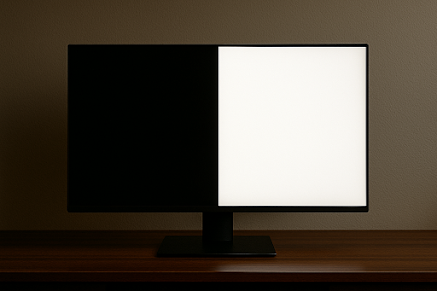Transform Your Projector Setup with Professional Black Screen Lighting Control
Projector performance depends heavily on ambient lighting control, but most users struggle with achieving cinema-quality darkness. Professional AV technicians use black screen testing to optimize lighting conditions and maximize image contrast, creating immersive viewing experiences that rival commercial theaters.
Why Black Screens Reveal Projector Lighting Issues
Projectors can't produce true black like OLED displays - they rely on the absence of light projection. Ambient lighting fills these "black" areas with unwanted illumination, destroying contrast ratios and washing out image quality. Black screen testing exposes these lighting problems before you invest time in content setup.
Even minimal ambient light dramatically reduces projector contrast performance. Room lighting that seems dim to your eyes can completely overwhelm a projector's ability to display dark scenes effectively. Professional installations require systematic lighting control that most home users overlook.
Professional Black Screen Testing Method
Begin lighting optimization by navigating to blackscreen.onl and projecting a pure black image onto your screen or wall. This baseline test reveals how much ambient light contaminates your viewing area. Quality projection setups should display deep, uniform darkness across the entire projected area.
Walk around your projection space while observing the black screen from different angles. Light reflections from walls, ceilings, and furniture often create hot spots that reduce image quality. Professional AV installers use this technique to identify lighting problems during initial setup phases.
Systematic Lighting Control Process
Start with complete darkness - turn off all lights and close window coverings. Project the black screen from blackscreen.onl to establish your optimal baseline performance. This represents your projector's maximum contrast potential under ideal conditions.
Gradually introduce lighting elements one at a time while monitoring black screen quality. Add bias lighting behind your projection screen first, then introduce minimal task lighting as needed. Each lighting addition should be evaluated against your baseline black screen performance.
Document lighting configurations that maintain acceptable black levels. Professional installations often require custom lighting control systems, but home users can achieve excellent results with careful planning and systematic testing.
Advanced Projector Optimization Techniques
Professional projection installations incorporate sophisticated lighting control strategies that maximize image quality. Understanding advanced lighting control methods helps achieve cinema-quality results in home environments.
Photography principles apply directly to projection lighting design. Learning how photographers control lighting environments provides valuable insights for optimizing projection spaces and eliminating unwanted light contamination.
Room Design Considerations for Projectors
Wall colors dramatically affect projector performance by reflecting light back onto the projection surface. Use blackscreen.onl to test how different wall treatments impact black level performance. Dark, matte wall finishes minimize light reflection and improve contrast ratios.
Ceiling height and color influence ambient light distribution throughout your projection space. High, dark ceilings reduce light bounce that can contaminate projected images. Test various room configurations using black screen projection to identify optimal arrangements.
Furniture placement affects light reflection patterns that impact image quality. Glossy surfaces, light-colored upholstery, and metallic accents can create unwanted reflections that reduce contrast. Position reflective elements outside the projection light path whenever possible.
Screen Selection and Black Level Performance
Projection screen materials significantly impact black level reproduction and overall contrast performance. Gray screens improve contrast in rooms with some ambient light by absorbing more projected light while maintaining color accuracy. Test different screen options using blackscreen.onl to compare performance.
Screen gain affects how much light reflects back to viewers versus absorbing into the screen material. Higher gain screens appear brighter but may create hot spots or viewing angle limitations. Lower gain screens provide more uniform illumination with better black levels.
Ambient light rejecting (ALR) screens use specialized coatings to reject ceiling-mounted lighting while preserving projected image quality. These expensive screens justify their cost in rooms where complete darkness isn't achievable.
Professional Installation Standards
Commercial projection installations maintain strict ambient light specifications to ensure consistent image quality. Professional AV technicians measure ambient light levels and adjust room lighting accordingly to meet industry standards for different application types.
Home theater installations often require dedicated rooms with complete lighting control capabilities. Professional designers use black screen testing throughout the design process to optimize room layouts and lighting systems.
Troubleshooting Common Lighting Problems
Light leakage around windows and doors creates uneven illumination that degrades image quality. Use black screen projection to identify leak sources, then address them with appropriate light-blocking materials. Professional installations often require custom window treatments and door seals.
HVAC vents can introduce unwanted light reflections or create air currents that affect projection quality. Test your system with blackscreen.onl while HVAC systems operate to identify potential interference issues.
Neighboring room lighting can bleed through shared walls or doorways, contaminating your projection environment. Systematic testing helps identify external light sources that require attention during room preparation.
Measuring and Maintaining Performance
Document your optimized lighting configurations with detailed notes about light positions, intensities, and room conditions. This information helps recreate optimal viewing conditions and troubleshoot future performance issues.
Regular testing with black screen projection ensures your lighting control system maintains optimal performance over time. Bulb aging, room modifications, and equipment changes can all impact previously optimized lighting setups.
Budget-Friendly Lighting Solutions
Achieve professional results without expensive control systems by using strategic lamp placement and manual dimming controls. Test different configurations using black screen projection to identify cost-effective solutions that deliver significant performance improvements.
DIY light control projects like blackout curtains, acoustic panels, and strategic furniture arrangement can dramatically improve projector performance. Use systematic black screen testing to evaluate each modification's impact on overall image quality.
Professional projector setup requires understanding the critical relationship between ambient lighting and image quality. By using systematic black screen testing and implementing proper lighting control strategies, you can achieve cinema-quality projection performance that transforms your viewing experience and maximizes your equipment investment.

.png)


Comments
Post a Comment